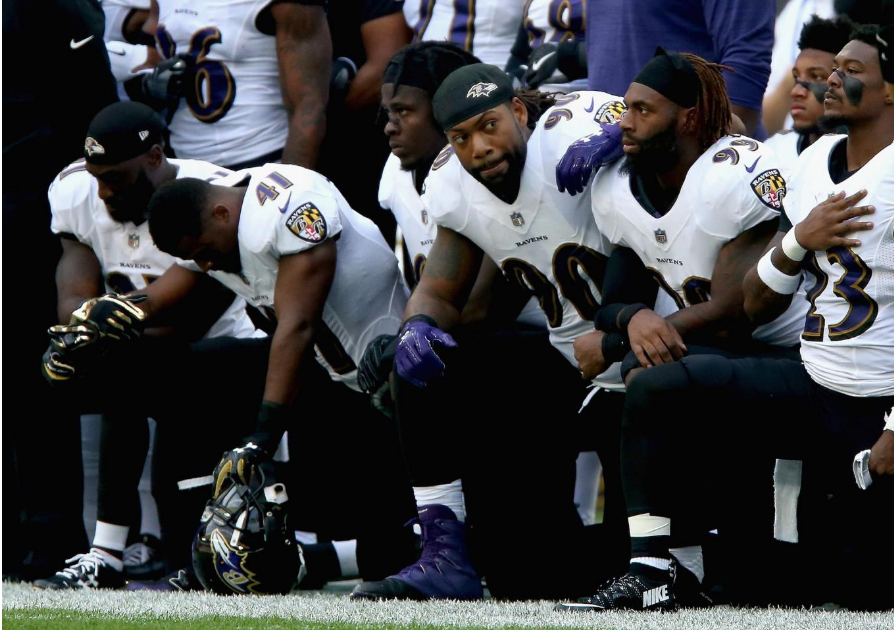Amid Trump's NFL war - Photos of Martin Luther King Jr 'taking a knee' resurface

Amid President Donald Trump's escalating war on NFL players who take a knee during the national anthem, photos of civil rights leader Martin Luther King Jr. kneeling in prayer - and protest - resurfaced online over the weekend.
On Saturday, the nonprofit Martin Luther King Jr. Center for Nonviolent Social Change tweeted one of the first images, of King down on his left knee in Selma, Alabama, on Feb. 1, 1965. To his left is friend and fellow civil rights leader Ralph Abernathy, head bowed in prayer. Behind them is a long line of protesters, similarly demonstrating peacefully.
Police that day had arrested more than 250 people for parading without a permit as the group had marched to the Dallas County courthouse to register voters. Those arrested eventually would march to jail.
But first, they took a knee.
Bernice King, the chief executive of the King Center and the daughter of the civil rights leader, had tweeted a similar photo earlier Saturday, seemingly comparing her father's actions to those of former San Francisco 49ers quarterback Colin Kaepernick, who began kneeling during the national anthem last season to bring attention to police brutality and racial injustice.
"The real shame and disrespect," Bernice King wrote Saturday, "is that, decades after the 1st photo, racism STILL kills people & corrupts system."
In the post she tagged #TakeAKnee, a burgeoning social-media campaign that encouraged NFL players the following day to kneel during the national anthem to show solidarity with those protesting racial injustice and/or in defense of the First Amendment.
"Wouldn't you love to see one of these NFL owners, when somebody disrespects our flag, to say, 'Get that son of a b-- off the field right now, out. He's fired. He's fired!' " Trump told the crowd at the rally, which responded by cheering.
Despite - or perhaps encouraged by - a statement from NFL Commissioner Roger Goodell calling Trump's remarks "divisive" and disrespectful, the president continued doubling down on his comments the following day. (He also incurred the wrath of many in the NBA after snubbing Golden State Warriors player Stephen Curry on Twitter.)
"Roger Goodell of NFL just put out a statement trying to justify the total disrespect certain players show to our country.Tell them to stand!" Trump tweeted.
What followed was a slew of people pointing out that kneeling had long been used as a form of nonviolent protest. Eric Holder, who was attorney general under President Barack Obama, noted in a message directed to Trump - using the same photo of King at Selma - that the practice was "not without precedent."
"Those who dared protest have helped bring about positive change," Holder tweeted.
The Rev. William Barber - a North Carolina preacher once called "the closest person we have to Martin Luther King Jr. in our midst" - said NFL players who took a knee were "sons of Justice, taking their place in the river of resistance that has brought us thus far on our way."
Some critics have argued that their issue with NFL players taking a knee is not so much the act of kneeling alone but doing so during the national anthem. To do so, they say, is a form of disrespect against the country, the flag and those who fought for its freedoms. Supporters have countered by saying that those freedoms - specifically the First Amendment right to peacefully protest - are precisely what the country and flag represent.
"We can disagree about the method as long as we're on the same page about the message. We can discuss the method so long as there's no antagonism," Harry Edwards, a civil rights activist professor emeritus of sociology at the University of California at Berkeley, said at a Harvard forum earlier this month. "But it can't be about Ray Lewis versus Kaepernick, about Michael Vick versus Kaepernick. It's not about Kaepernick cutting his hair or . . . talking softer. Those are not the issues."
However, constructive conversations can seldom reach the underlying reasons for the protest because of pushback against the methods of protest themselves. That, too, is not new.
As The Washington Post reported last year, public opinion of civil rights-era protests was also low at that time:
"In 1961, mobs in Southern cities attacked Freedom Riders, the activists testing the federal ban on bus segregation. Most Americans weren't on the activists' side; 61 percent said they disapproved 'of what the "Freedom Riders" are doing,' according to a 1961 Gallup Poll.
"That same poll found that 57 percent of Americans felt the 'Freedom buses,' sit-ins at lunch counters and 'other demonstrations' by African-Americans would hurt their chances of being integrated in the South. Just 28 percent of Americans said these actions would help.
". . . Even the March on Washington - so revered today - wasn't welcomed. Just before the 1963 march, Gallup asked a nationally representative sample of adults how they felt about the coming event. Less than a quarter of Americans said they held favorable opinions."
Bernice King confirmed as much in follow-up tweets Sunday. Her father, too, had been considered an "outside agitator," she said.
"No form of protest, even nonviolent direct action, will be approved by people 'more dedicated to order than to justice' or by the unjust," Bernice King tweeted. "Many who quote #MLK today, and use his words out of context to deter nonviolent protest, would have hated him openly then."
Washington Post
Join our commenting forum
Join thought-provoking conversations, follow other Independent readers and see their replies
Comments